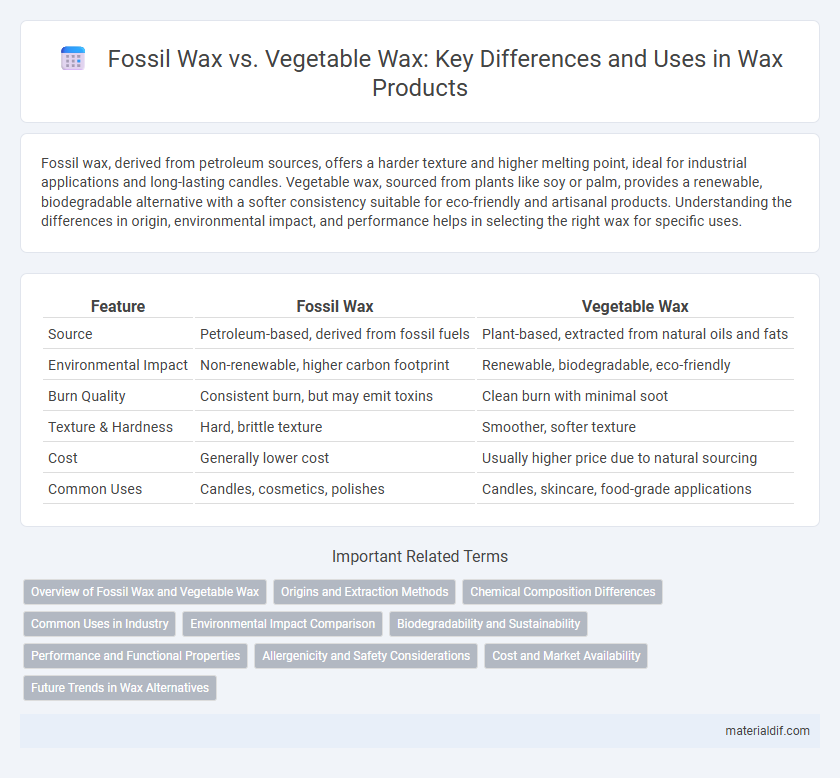Fossil wax, derived from petroleum sources, offers a harder texture and higher melting point, ideal for industrial applications and long-lasting candles. Vegetable wax, sourced from plants like soy or palm, provides a renewable, biodegradable alternative with a softer consistency suitable for eco-friendly and artisanal products. Understanding the differences in origin, environmental impact, and performance helps in selecting the right wax for specific uses.
Table of Comparison
| Feature | Fossil Wax | Vegetable Wax |
|---|---|---|
| Source | Petroleum-based, derived from fossil fuels | Plant-based, extracted from natural oils and fats |
| Environmental Impact | Non-renewable, higher carbon footprint | Renewable, biodegradable, eco-friendly |
| Burn Quality | Consistent burn, but may emit toxins | Clean burn with minimal soot |
| Texture & Hardness | Hard, brittle texture | Smoother, softer texture |
| Cost | Generally lower cost | Usually higher price due to natural sourcing |
| Common Uses | Candles, cosmetics, polishes | Candles, skincare, food-grade applications |
Overview of Fossil Wax and Vegetable Wax
Fossil wax, derived from petroleum or mineral coal sources, offers a dense, hard texture ideal for long-lasting candles and industrial applications. Vegetable wax, extracted from plant-based materials such as soy, palm, or coconut, provides a renewable, biodegradable alternative with a softer consistency and natural scent retention. Both wax types vary significantly in environmental impact, melting points, and typical uses, influencing choice in candle making, cosmetics, and packaging industries.
Origins and Extraction Methods
Fossil wax, primarily derived from petroleum or coal tar, originates from ancient organic materials subjected to intense heat and pressure over millions of years, making its extraction reliant on complex refining and distillation processes. Vegetable wax, sourced from plants such as soybeans, carnauba palm, and candelilla, is obtained through natural methods including solvent extraction, cold pressing, or hydrogenation of plant oils. The fundamental difference lies in fossil wax being a non-renewable resource with chemical processing, whereas vegetable wax is renewable, eco-friendly, and extracted via sustainable botanical methods.
Chemical Composition Differences
Fossil wax, derived from petroleum, consists primarily of long-chain hydrocarbons such as paraffins and microcrystalline waxes, characterized by a stable carbon structure and high melting points. Vegetable waxes contain esters of fatty acids and long-chain alcohols, originating from plant oils, resulting in more biodegradable and renewable profiles with lower melting points. The chemical composition differences influence their physical properties, ecological impact, and suitability for applications like candle making and cosmetics.
Common Uses in Industry
Fossil wax, derived from petroleum, is widely used in industrial applications such as candles, crayons, and coatings due to its hardness and relatively low melting point. Vegetable wax, sourced from plant-based materials like soy or palm, is preferred in eco-friendly products, including natural candles, cosmetics, and food-grade coatings, due to its biodegradability and renewable nature. Both wax types serve critical roles in packaging, lubrication, and cosmetics, tailored by their distinct chemical compositions and environmental impacts.
Environmental Impact Comparison
Fossil wax, derived from petroleum, contributes significantly to carbon emissions and environmental pollution due to its non-renewable origin and energy-intensive extraction processes. Vegetable waxes, sourced from plants like soy, coconut, and palm, offer a more sustainable alternative with lower greenhouse gas emissions and better biodegradability. Choices favoring vegetable waxes support reduced ecological footprints and promote renewable resource use in candle and cosmetic industries.
Biodegradability and Sustainability
Vegetable waxes derived from renewable plant sources such as soy, palm, and candelilla exhibit superior biodegradability compared to fossil waxes made from petroleum byproducts, which persist longer in the environment. Sustainable agriculture practices linked to vegetable wax production reduce carbon footprints and promote ecosystem health, whereas fossil wax extraction involves energy-intensive processes with higher greenhouse gas emissions. Choosing vegetable wax supports circular economy principles by enhancing soil biodegradation rates and minimizing ecological contamination.
Performance and Functional Properties
Fossil wax, derived from petroleum, offers superior hardness, melting point stability, and excellent oil retention, making it ideal for high-performance applications like candles and coatings requiring durability and slow burn times. Vegetable wax, sourced from sustainable plant oils such as soy or palm, provides better biodegradability and a cleaner burn with lower soot emissions but tends to have a lower melting point and softer texture, affecting its longevity and heat resistance. Choosing between fossil and vegetable wax depends on the desired balance of environmental impact versus functional performance in specific industrial or consumer uses.
Allergenicity and Safety Considerations
Fossil wax, derived from petroleum, often contains hydrocarbons that may cause skin irritation or allergic reactions in sensitive individuals. Vegetable wax, sourced from plant materials like soy or palm, generally presents lower allergenicity and is considered safer for skin contact and indoor use. Evaluating ingredient purity and potential contaminants is crucial for ensuring safety, especially in cosmetic and therapeutic applications.
Cost and Market Availability
Fossil wax, derived from petroleum, generally offers lower production costs and greater market availability due to established extraction and refinement processes. Vegetable wax, sourced from renewable plant materials like soy or palm, tends to be pricier and less prevalent but appeals to eco-conscious consumers seeking sustainable alternatives. Market trends show increasing demand for vegetable wax despite its higher cost, driven by growing environmental awareness and regulatory shifts favoring biodegradable products.
Future Trends in Wax Alternatives
Fossil wax, derived from petroleum, faces increasing scrutiny due to environmental concerns and the push for sustainable materials, driving innovation in vegetable wax alternatives sourced from soy, palm, and coconut oils. Future trends highlight the development of bio-based waxes with enhanced biodegradability and lower carbon footprints, responding to consumer demand for eco-friendly products in candles, cosmetics, and packaging. Advances in biotechnology and green chemistry are anticipated to improve the performance and scalability of vegetable waxes, positioning them as viable, sustainable substitutes in the wax market.
Fossil Wax vs Vegetable Wax Infographic

 materialdif.com
materialdif.com